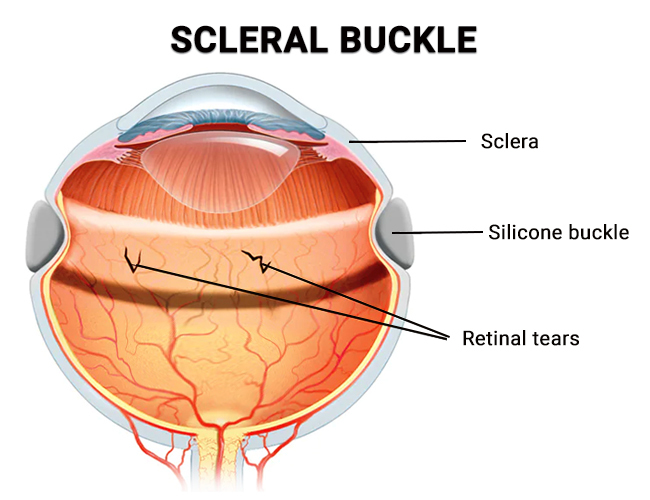Scleral buckling is a surgical procedure to repair a retinal detachment. Retinal detachment occurs when the retina becomes separated from the back wall of the eye, usually due to the development of a retinal tear.
A scleral buckle is a thin strip of silicone shaped like a belt that is placed around the eye. The scleral buckle gently indents the sclera, or white of the eye, towards the middle, relieving the tension on the retina and narrowing the space between the two layers that have been pulled apart. This allows the retina to settle back into the proper position.
The scleral buckling procedure is usually performed in the operating room as an outpatient procedure. The retina surgeon will determine whether to apply local or general anesthesia depending on the specific case. In addition, eye drops will be applied to dilate the pupils.
During the procedure, the scleral buckle is secured around the eyeball onto the sclera. It is positioned behind the eyelids and the muscles that move the eye and is not externally visible. A scleral buckle is usually left around the eye permanently.

After placement of the scleral buckle, patients may experience the following for a few days:
The retinal surgeon may prescribe eye drops to treat these symptoms and reduce the risk of infection.
It is important to follow the retina specialist’s scleral buckle surgery recovery instructions. Patients will need to arrange for someone to drive them home after their eye surgery. They may also need to wear an eye patch for a day or two. Patients should avoid driving and physical exertion until cleared by their surgeon.
Most patients experience a shift in vision after surgery, often requiring a change in prescription glasses or contact lenses after the eye heals.
Although scleral buckling surgery is considered safe for most patients, there are certain risks associated with the scleral buckling procedure, including:
Patients should contact their physician if they experience any of the following after scleral buckle surgery:
Any new floaters or flashes of light in your field of vision
Download Patient Instructions for Care after Retina Surgery.